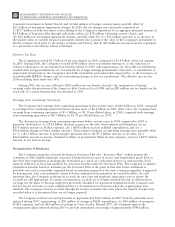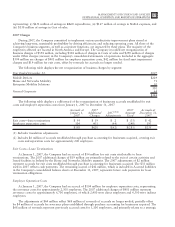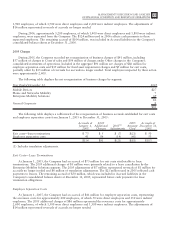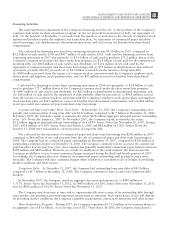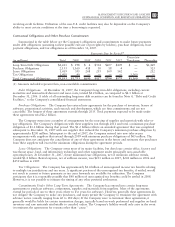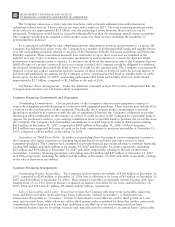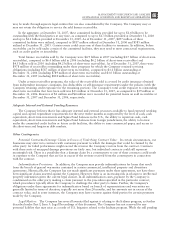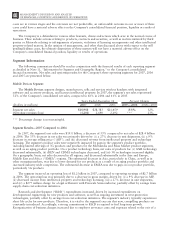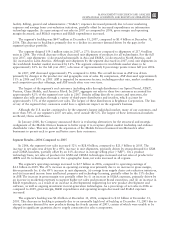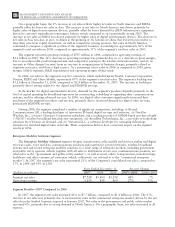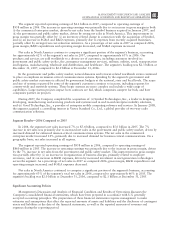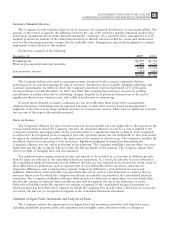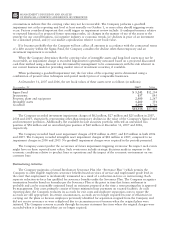Motorola 2007 Annual Report Download - page 64
Download and view the complete annual report
Please find page 64 of the 2007 Motorola annual report below. You can navigate through the pages in the report by either clicking on the pages listed below, or by using the keyword search tool below to find specific information within the annual report.
The Company outsources certain corporate functions, such as benefit administration and information
technology-related services. These contracts are expected to expire in 2013. The total remaining payments under
these contracts are approximately $1.1 billion over the remaining 6 years; however, these contracts can be
terminated. Termination would result in a penalty substantially less than the remaining annual contract payments.
The Company would also be required to find another source for these services, including the possibility of
performing them in-house.
As is customary in bidding for and completing network infrastructure projects and pursuant to a practice the
Company has followed for many years, the Company has a number of performance/bid bonds and standby letters
of credit outstanding, primarily relating to projects of the Enterprise Mobility Solutions and Home and Networks
Mobility segments. These instruments normally have maturities of up to three years and are standard in the
industry as a way to give customers a convenient mechanism to seek resolution if a contractor does not satisfy
performance requirements under a contract. A customer can draw on the instrument only if the Company does not
fulfill all terms of a project contract. If such an occasion occurred, the Company would be obligated to reimburse
the financial institution that issued the bond or letter of credit for the amounts paid. The Company is not generally
required to post any cash in connection with the issuance of these bonds or letters of credit. In its long history, it
has been extraordinarily uncommon for the Company to have a performance/bid bond or standby letter of credit
drawn upon. At December 31, 2007, outstanding performance/bid bonds and standby letters of credit totaled
approximately $1.7 billion, compared to $1.5 billion at the end of 2006.
Off-Balance Sheet Arrangements: Under the definition contained in Item 303(a)(4)(ii) of Regulation S-K, the
Company does not have any off-balance sheet arrangements.
Customer Financing Commitments and Guarantees
Outstanding Commitments: Certain purchasers of the Company’s infrastructure equipment continue to
request that suppliers provide financing in connection with equipment purchases. These requests may include all or
a portion of the purchase price of the equipment. Periodically, the Company makes commitments to provide
financing to purchasers in connection with the sale of equipment. However, the Company’s obligation to provide
financing is often conditioned on the issuance of a letter of credit in favor of the Company by a reputable bank to
support the purchaser’s credit or a pre-existing commitment from a reputable bank to purchase the receivable from
the Company. The Company had outstanding commitments to extend long-term credit to third parties totaling
$610 million at December 31, 2007, compared to $398 million at December 31, 2006. Of these amounts,
$454 million was supported by letters of credit or by bank commitments to purchase receivables at December 31,
2007, compared to $262 million at December 31, 2006.
Guarantees of Third-Party Debt: In addition to providing direct financing to certain equipment customers,
the Company also assists customers in obtaining financing directly from banks and other sources to fund
equipment purchases. The Company had committed to provide financial guarantees relating to customer financing
totaling $42 million and $122 million at December 31, 2007 and December 31, 2006, respectively (including
$23 million and $19 million at December 31, 2007 and 2006, respectively, relating to the sale of short-term
receivables). Customer financing guarantees outstanding were $3 million and $47 million at December 31, 2007
and 2006, respectively (including $0 million and $2 million at December 31, 2007 and 2006, respectively, relating
to the sale of short-term receivables).
Customer Financing Arrangements
Outstanding Finance Receivables: The Company had net finance receivables of $118 million at December 31,
2007, compared to $269 million at December 31, 2006 (net of allowances for losses of $5 million at December 31,
2007 and $10 million at December 31, 2006). These finance receivables are generally interest bearing, with rates
ranging from 3% to 14%. Interest income recognized on finance receivables for the years ended December 31,
2007, 2006 and 2005 was $7 million, $9 million and $7 million, respectively.
Sales of Receivables and Loans: From time to time, the Company sells short-term receivables, long-term
loans and lease receivables under sales-type leases (collectively, “finance receivables”) to third parties in
transactions that qualify as “true-sales.” Certain of these finance receivables are sold to third parties on a one-
time, non-recourse basis, while others are sold to third parties under committed facilities that involve contractual
commitments from these parties to purchase qualifying receivables up to an outstanding monetary limit.
Committed facilities may be revolving in nature and, typically, must be renewed on an annual basis. Certain sales
56 MANAGEMENT’S DISCUSSION AND ANALYSIS
OF FINANCIAL CONDITION AND RESULTS OF OPERATIONS


